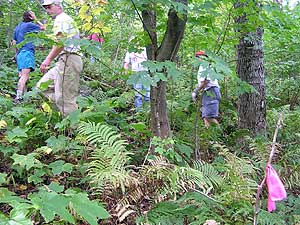|
Audio
Photos
Resources
Respond to this story
|
Bringing the trail through Duluth
September 22, 2004
The 240-mile Superior Hiking Trail is growing. It's being extended 40 miles to and through the city of Duluth -- a key connection to a planned national trail through seven states. A small group of volunteers is taking advantage of late summer weather in Duluth, to build part of the trail.
Duluth, Minn. — Four men and one woman are following a trail of pink ribbons through the woods. The group is loaded with tools.
"We're out, a group of five of us today, building the Superior Hiking Trail through Duluth," says Judy Gibbs, with the Superior Hiking Trail Association.
They're working in the city limits.
"But you wouldn't know it right here, right now," says Gibbs. "You can hear the creek below, and as far as you can see it's just trees and shrubs, and it's beautiful sun out. It's great."
They walk on. They pass the creek, and climb up a hill.
 | |||
"The Superior Hiking trail -- most people know it as about 250 miles from Two Harbors to the Canadian border. And there's been an effort the last three years to extend that down from Two Harbors, through the City of Duluth, to hook up to Jay Cooke Park. And then it's going to go eastward and become part of the North Country Trail Association -- the national trail," Gibbs says.
"Then it will go up from the Superior Hiking Trail, goes across the border route, and to the Kekekabic and then on westward. So it's part of a huge national trail system, or will be. Right now though, we're just trying to get this through town, and we've got about 40 miles to put in," Gibbs says.
The crew is scouting for the best path.
"A lot of it will be on existing trail," says Gibbs. "For example, we'll be going through the Lincoln Park neighborhoods, and we'll be going down the Kingsberry Creek trails. There will be a sidewalk here and there, and I guess that's to be expected in a large urban area, that there will be," she says. "But I think people are going to be surprised to find that the backbone of this trail will be through just incredible green space that we've got. We're just blessed with it in Duluth."
 | |||
With the best path chosen, the crew members get to work. They use common tools like rakes and a hand trimmer, and some uncommon ones, like a big scraper thing with teeth. Mostly they use something usually just called "the tool."
"It's the main tool we build the trail with. Its official name I guess is a mattock. It's kind of got a big grub hoe on one end, and a sort of a blunt axe on the other," Gibbs says. "It weighs, I don't know, a good 20, 25 pounds. And you just let the weight of the tool do the work. It's kind of fun. It does everything on this trail."
Gibbs swings the tool, and dislodges a rock. Then she cuts one side of the trail, and scrapes the dirt to the other side.
"You can see how the trail is slanted here. And so one of the things we'll be doing is taking the high end of the trail and bringing it over to the low end -- making a flat surface. And that helps the water to run off later on, and makes it a nice footpath to walk on," says Gibbs. "Right now we're just doing initial grubbing out of roots and things, so we can see where we have to do this other kind of work."
|
I'm not sure what all these people exactly get out of coming out to work on the trail, but they keep coming, day after day after day. It's hard work. They go home -- they're sweaty, they're dirty, they're filthy. And then they come back the next day, in clean clothes.
- Judy Gibbs |
But Gibbs can't bring herself to cut a large root. She knows it's coming from a nearby white birch, and the tree is already struggling to survive. So she packs a little dirt around it. Gibbs is a naturalist -- she can name every tree, bush, and fungus on the hillside.
"It's terrible, because as I go through here I'm like constantly saying, 'Oh my gosh, there's the pyrola, and we're going to be digging this up,' or 'Oh, look at that beautiful large leaf aster, and it's blooming,' or 'We'd better eat these blueberries before we just kill them!'"
She hacks at the dark soil, over and over again.
"You get into this rhythm of just working, over, and over, and over again. And just that repetitive motion is kind of nice. Your brain just kind of engages in it without rule of thought. It's kind of nice. It's almost meditation. Until you hit the rocks," Gibbs says. "Rocks equal a lot of work."
Slowly, the trail takes shape. There's a clear dark path winding through birch and brush down the hillside. More than 130 volunteers have helped this summer, to complete about eight miles of new trail. Only 32 miles to go.
"I'm not sure what all these people exactly get out of coming out to work on the trail, but they keep coming, day after day after day," Gibbs says. "It's hard work. They go home -- they're sweaty, they're dirty, they're filthy. And then they come back the next day, in clean clothes."
Trail clearing will continue into the fall, as long as the weather holds out.
|
News Headlines
|
Related Subjects
|

